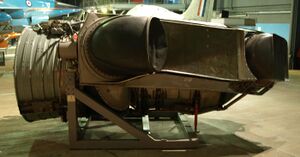Engineering:Bristol Siddeley BS100
| BS.100 | |
|---|---|

| |
| Bristol Siddeley BS.100 on display at the Fleet Air Arm Museum. | |
| Type | Vectored thrust turbofan |
| Manufacturer | Bristol Siddeley Engines Limited |
| First run | 1960 |
| Major applications | Hawker Siddeley P.1154 (intended) |
| Number built | 6 |
The Bristol Siddeley BS.100 was a British twin-spool, vectored thrust, turbofan aero engine that first ran in 1960. The engine was designed and built in limited numbers by Bristol Siddeley Engines Limited. The project was cancelled in early 1965.
Design and development
Based on the 300-series Olympus,[1] the BS.100 was similar in general arrangement to that of the company's Pegasus design, but with the addition of plenum chamber burning (PCB), to enable the projected Hawker Siddeley P.1154 VSTOL fighter design to accelerate to supersonic speed.[2] PCB is akin to reheat, but is only applied to the bypass stream (i.e. the front nozzles), as the flow turns from fan exit to the nozzle bearing plane. Variable area front nozzles were required, to maintain consistent fan matching regardless of whether the PCB was alight.
The BS.100 was also intended for the Fokker Republic D-24.[3][4]
Variants
- BS.100-3
Engines on display
A preserved Bristol Siddeley BS.100 is on public display at the Fleet Air Arm Museum, RNAS Yeovilton.
Specifications (BS.100-3)
Data from Aircraft engines of the World 1966/67[5]
General characteristics
- Type: Vectored thrust after-burning Turbofan with Plenum Chamber Burning (PCB)
- Length: 148 in (3,800 mm)
- Diameter: 60 in (1,500 mm)
- Dry weight: 4,000 lb (1,800 kg)
Components
- Compressor: Two-spool axial flow, 3-stage LP compressor fan, with 7-stage HP compressor
- Combustors: annular with 20 spill type burner nozzles
- Turbine: HP single-stage with 2-stage LP turbines
- Fuel type: D.Eng.R.D.2494 / 2486 / 2498 / JP-1 / JP-4 / JP-5
- Oil system: Return system 50 psi (340 kPa)
Performance
- Maximum thrust:
- 27,000 lbf (120.10 kN) PCB off
- 33,800 lbf (150.35 kN) short lift thrust, PCB on
- Overall pressure ratio: 16:1
- Bypass ratio: 1.2:1
- Air mass flow: 650 lb/s (17,690.1 kg/min)
- Specific fuel consumption: 0.58 lbf/lb (0.0057 kN/kg)
- Thrust-to-weight ratio: 8.45
See also
Related development
Comparable engines
- Rolls-Royce/MAN Turbo RB193
Related lists
References
Notes
- ↑ http://www.flightglobal.com/pdfarchive/view/1962/1962%20-%200761.html
- ↑ Gunston 1989, p.38.
- ↑ http://www.flightglobal.com/pdfarchive/view/1962/1962%20-%201016.html
- ↑ http://www.flightglobal.com/airspace/media/experimentalaircraftcutaways/fokker-republic-d-24-cutaway-9325.aspx
- ↑ Wilkinson, Paul H. (1966). Aircraft engines of the World 1966/67 (21st ed.). London: Sir Isaac Pitman & Sons Ltd.. p. 117.
Bibliography
- Gunston, Bill. World Encyclopedia of Aero Engines. Cambridge, England. Patrick Stephens Limited, 1989. ISBN:1-85260-163-9
External links

